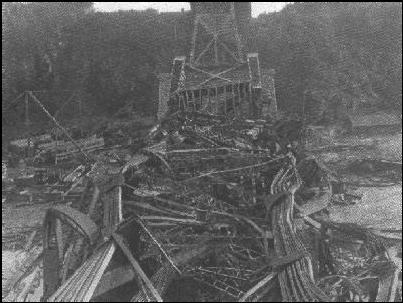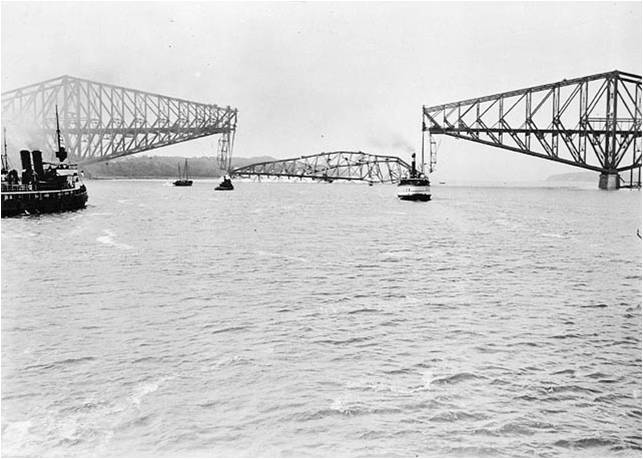Chapter 3 Engineering Disasters
Infrastructure Disaster – Quebec Bridge 1907
Quebec City Bridge
The Quebec Bridge is a road, rail, and pedestrian bridge across the lower Saint Lawrence River between Sainte-Foy and Lévis, near Quebec City, Quebec, Canada.
The project failed twice during its construction, in 1907 and 1916, at the cost of 88 lives and additional persons injured. It took more than 30 years to complete and eventually opened in 1919.
https://en.wikipedia.org/wiki/Quebec_Bridge#First_design_and_collapse_of_August_29,_1907
First design and collapse of August 29, 1907

Wreckage of the 1907 collapse
The Quebec Bridge was included in the National Transcontinental Railway project, undertaken by the federal government. The Quebec Bridge Company was first incorporated by Act of Parliament under the government of Sir John A. Macdonald in 1887,[2] later revived in 1891,[3] once again revived for good in 1897 by the government of Wilfrid Laurier,[4] who granted them an extension of time in 1900.[5] In 1903, the bond issue was increased to $6,000,000 and power to grant preference shares was authorised, along with a name change to the Quebec Bridge and Railway Company (QBRC).[6] An Act of Parliament the same year was necessary to guarantee the bonds by the public purse.[7] Laurier was MP for Quebec Eastriding, while the president of the QBRC, Simon-Napoleon Parent, simultaneously was Premier of Quebec from 1900 to 1905, and was Quebec City’s mayor from 1894 to 1906.[citation needed]
Edward A. Hoare was selected as Chief Engineer for the Company throughout this time,[8] while Collingwood Schreiber was the Chief Engineer of the Department of Railways and Canals in Ottawa.[9] Hoare had never worked on a cantilever bridge structure longer than 300 ft.[8][10] Schreiber was assisted until July 9, 1903 by Department bridge engineer R.C. Douglas, at which time Douglas was deposed for his opposition to the calculations that were submitted by the contractors.[11] Schreiber subsequently requested the support of another qualified bridge engineer, but was effectively overruled by the Cabinet on August 15, 1903. Thereafter, QBRC consulting engineer Theodore Cooper was completely in charge of the works,[12] and on July 1, 1905,[9] Schreiber was demoted and replaced as deputy minister and chief engineer by MJ Butler.[9][13]
By 1904, the southern half of the structure was taking shape. However, preliminary calculations made early in the planning stages were never properly checked when the design was finalized, and the actual weight of the bridge was far in excess of its carrying capacity. The dead load was too heavy. All went well until the bridge was nearing completion in the summer of 1907, when the QBRC site engineering team under Norman McLure began noticing increasing distortions of key structural members already in place.[citation needed]
McLure became increasingly concerned and wrote repeatedly to QBRC consulting engineer Theodore Cooper, who at first replied that the problems were minor. The Phoenix Bridge Company officials claimed that the beams must already have been bent before they were installed, but by August 27 it had become clear to McLure that this was wrong. A more experienced engineer might have telegraphed Cooper, but McLure wrote him a letter, and then went to New York to meet with him on August 29, 1907. Cooper then agreed that the issue was serious, and promptly telegraphed to the Phoenix Bridge Company: “Add no more load to bridge till after due consideration of facts.” The two engineers then went to the Phoenix offices.[citation needed]
However, the message had not been passed on to Quebec before it was too late. Near quitting time that same afternoon, after four years of construction, the south arm and part of the central section of the bridge collapsed into the St. Lawrence River in just 15 seconds. Of the 86 workers on the bridge that day, 75 were killed and the rest were injured,[14] making it the world’s worst bridge construction disaster. Of these victims, 33 (some sources say 35) were Mohawk steelworkers from the Kahnawake reserve near Montreal; they were buried at Kahnawake under crosses made of steel beams.[15]
On August 30, 1907, a Royal Commission of inquiry into the disaster was provisionally appointed by the Deputy Minister in charge of the Department of Railways and Canals (Butler), with the concurrence of the Minister. The Royal Commission, which was granted by Edward VII by advice of his Governor General, Albert Grey, on August 31, 1907, consisted of three members, who were all engineers of good standing: Mr. Henry Holgate, of Montreal, Mr. JGG Kerry, of Campbellford, Ontario also an instructor at McGill University, and Professor John Galbraith, then dean of the Faculty of Applied Science and Engineering at the University of Toronto. The Commission document conferred upon the commissioners full powers to summon witnesses and documents, and to express “any opinion they may see to express thereon”. The Commissioners presented their Report in full on February 20, 1908, issued 15 conclusions, and included the hindsight work of consulting bridge engineer C.C. Schneider, of Philadelphia (a fulfillment of the 1903 request of Schreiber, supra).[16]
The Commissioners found responsibility for the failure to lie at the feet of two men, consulting engineer Theodore Cooper and Peter L. Szlapka, Chief Designing Engineer for Phoenix Bridge Company:
(c) The design of the chords that failed was made by Mr. P.L. Szlapka, the designing engineer of the Phoenix Bridge Company
(d) This design was examined and officially approved by Mr. Theodore Cooper, consulting engineer of the Quebec Bridge and Railway Company.
(e) The failure cannot be attributed directly to any cause other than errors in judgment on the part of these two engineers.
Cooper escaped penal sanction.[17] It is presumed that Szlapka escaped as well. The Commissioners also found that:
(k) The failure on the part of the Quebec Bridge and Railway Company to appoint an experienced bridge engineer to the position of chief engineer was a mistake. This resulted in a loose and inefficient supervision of all parts of the work on the part of the Quebec Bridge and Railway Company.
The abortive construction of the Quebec Bridge spanned the careers of two Ministers of Railways and Canals, and one temporary replacement, who was on the job for five months immediately preceding the disaster.
Engineer Iron Rings Myth
A popular myth is that the iron and steel from the collapsed bridge, which could not be reused for construction, was used to forge the early Iron Rings worn by graduates of Canadian engineering schools starting in 1925.[18]

Second design and collapse of September 11, 1916
September 11, 1916 Quebec Bridge Collapse
After a Royal Commission of Inquiry into the collapse, construction started on a second bridge. Three engineers were appointed: H. E. Vautelet, a former engineer for the Canadian Pacific Railways, Maurice FitzMaurice from Britain, who worked on the construction of the Forth Bridge, and Ralph Modjeski from Chicago. Vautelet was President and Chief Engineer. The new design was again for a bridge with a single long cantilever span, but a much more massive one.
On September 11, 1916, when the central span was being raised into position, it fell into the river, killing 13 workers.[14] The chief engineer was made aware of the problem six weeks before the collapse by the engineer that was responsible for the construction of the centre section, Frants Lichtenberg. Frants Lichtenberg was also working as an inspector for the federal government of Canada at the time.[19][20] Immediately, fears of German sabotage were reported but it was soon clear that another tragic construction accident had befallen the structure (a problem with the hoisting devices). Re-construction began almost immediately after the accident and special permission granted for the bridge builders to acquire the steel that was in high demand because of the War effort. The fallen central span still lies at the bottom of the river. After the bridge’s completion in 1917, special passes were required for those wanting to cross the structure. Armed soldiers, and later Dominion Police, guarded the structure and checked passes until the end of the War.

Lifting the centre span in place was considered to be a major engineering achievement.
Construction was ultimately completed in August 1919, at a total cost of $25 million and 88 bridgeworkers’ lives. On December 3, 1919, the Quebec Bridge opened for rail traffic, after almost two decades of construction. Its centre span of 549 metres (1800 ft) remains the longest cantilevered bridge span in the world and is considered a major engineering feat.

